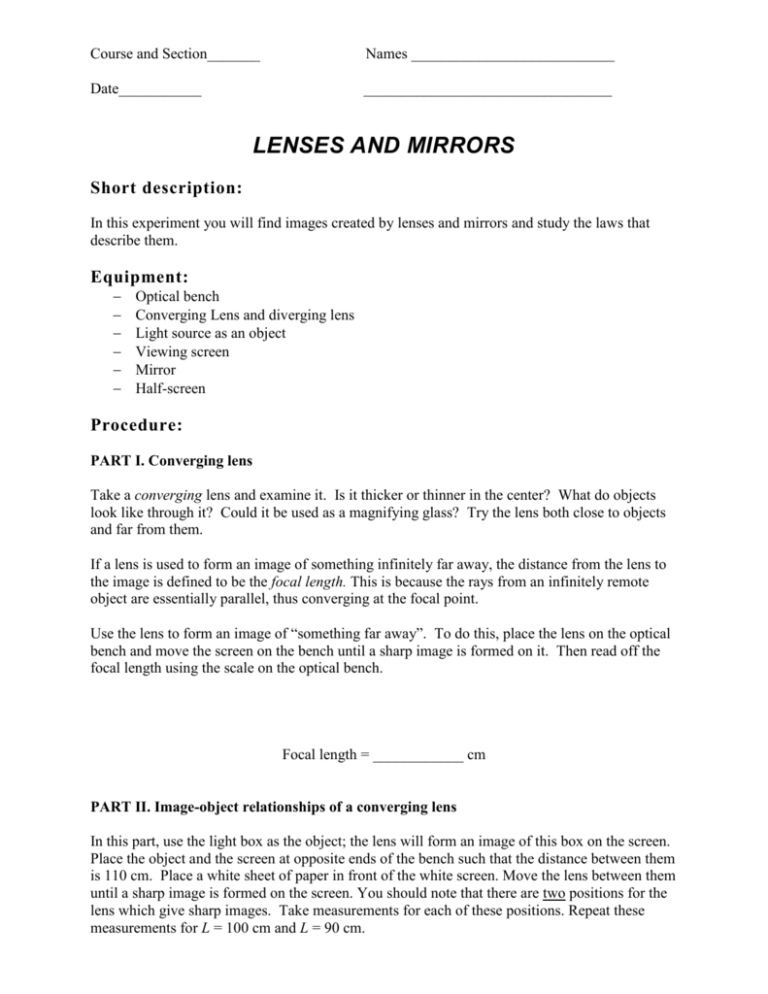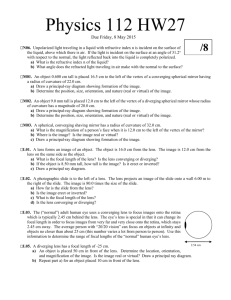Lenses and Mirrors
advertisement

Course and Section_______ Names ___________________________ Date___________ _________________________________ LENSES AND MIRRORS Short description: In this experiment you will find images created by lenses and mirrors and study the laws that describe them. Equipment: Optical bench Converging Lens and diverging lens Light source as an object Viewing screen Mirror Half-screen Procedure: PART I. Converging lens Take a converging lens and examine it. Is it thicker or thinner in the center? What do objects look like through it? Could it be used as a magnifying glass? Try the lens both close to objects and far from them. If a lens is used to form an image of something infinitely far away, the distance from the lens to the image is defined to be the focal length. This is because the rays from an infinitely remote object are essentially parallel, thus converging at the focal point. Use the lens to form an image of “something far away”. To do this, place the lens on the optical bench and move the screen on the bench until a sharp image is formed on it. Then read off the focal length using the scale on the optical bench. Focal length = ____________ cm PART II. Image-object relationships of a converging lens In this part, use the light box as the object; the lens will form an image of this box on the screen. Place the object and the screen at opposite ends of the bench such that the distance between them is 110 cm. Place a white sheet of paper in front of the white screen. Move the lens between them until a sharp image is formed on the screen. You should note that there are two positions for the lens which give sharp images. Take measurements for each of these positions. Repeat these measurements for L = 100 cm and L = 90 cm. Record the distance from the lens to the object (p) and the distance from the lens to the image (q). Measure also the height of the image (h’). Height of the object = _______________cm L (cm) p (cm) q (cm) h’ (cm) f (cm) h’/h q/p 110 110 100 100 90 90 The equation relating the image and object distances of a lens is 1 1 1 p q f Use this equation to calculate f from each set of data in the table, and fill in that part of the table. Do you get consistent values for the focal length f? Do these results agree with the focal length you found in the first part of this experiment? Which method do you think is the most accurate? Finally, fill in the last two columns of the table. Do you find that the two ratios are equal? PART III. Spherical mirror Determine the focal length of the concave side of the spherical mirror. Place the mirror on the bench facing the light box with some distance between them. Place the half-screen between the light box and the mirror and adjust the position of the half-screen until you obtain a sharp image on the half screen. Use the distances to calculate the focal length of the mirror. Repeat using a different distance between the light box and the mirror and again calculate the focal length. Are your results approximately the same? Focal length = ____________ cm Focal length = ____________ cm PART IV. Diverging lens A diverging lens will produce a virtual image of a real object. To observe this, place the lens on the optical bench some distance from the light box and look at the light box through the lens. In order for the diverging lens to produce a real image, you need to have a virtual object. That is, the object needs to be on the back side of the diverging lens. This virtual object can be produced by suitably placing a converging lens between the light box and the diverging lens. The image produced by the converging lens is real, but since it’s created on the back side of the diverging lens it’s becomes the virtual object for the diverging lens. By suitably adjusting the distances of the two lenses, the diverging lens will produce a real image on the screen. Use this method to determine the focal length of the diverging lens. Make a sketch of your setup and indicate the relevant distances. Focal length = ____________ cm







